Several users have enquired on how to install Chrome OS Flex in Windows 11. If you are one such user and don’t know where to begin, apply our workarounds and check if the issue gets resolved by then.

What is Chrome OS Flex?
Chrome OS Flex is a new project on which Google is currently working. Cloud-Ready is a Chromium OS-based operating system that transforms any computer into a Chrome OS device. Google has integrated Cloud Ready into its Chrome OS software package, making Chrome OS Flex effectively the next generation of Cloud Ready.
As a result, Chrome OS Flex is ready to become the preferred method of installing Chrome OS on a PC or Mac. Because it’s designed for easy mass deployment and control, Google is targeting companies and schools with this version. Regardless, for many individuals, it’s still a terrific method to obtain Chrome OS on their existing devices.
Minimum System requirements to install Chrome OS Flex
Before you proceed to downloading and installing the Chrome OS Flex, make sure to check its minimum system requirements. This is to ensure whether this OS runs smoothly on your computer or not. Here’s the list of minimum system prerequisites that your device must meet –
While Google only supports a limited number of devices, the operating system can be installed on almost any hardware that fits the following requirements:
- RAM – A minimum of 4 GB.
- ROM/Storage – At least 16 GB.
- System Architecture – x86 or x64-based Intel or AMD processors.
- BIOS with full administrator access.
How do I Install Chrome OS Flex on a Windows PC
Before you proceed to install Chrome OS Flex in Windows, you must create a bootable USB drive first. Here’s how to create a bootable Chrome OS Flex in your pen drive –
Creating a Bootable USB Drive
First of all, connect an 8 GB USB flash drive to one of your PC’s ports, and follow the below instructions –
- Launch Google Chrome, and reach out to Chromebook Recovery Utility. This is basically a native extension that supports creating a recovery mode for your Chromebook.
- Click Add to Chrome available on the top-right corner.

- A prompt should appear asking if you really want to add this extension. Well, click Add extension.
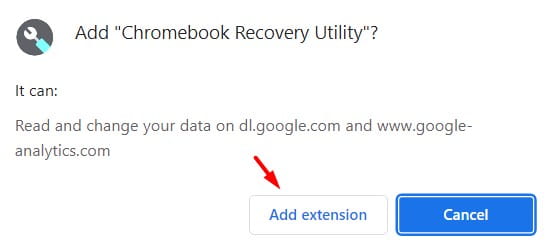
- Now, wait while this extension is downloading and installing on your Chrome browser.
- Click the Extensions icon available next to the address bar, and click on Chromebook Recovery Utility once.
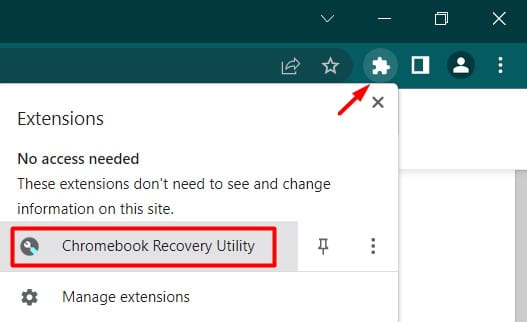
- Alternatively, you may also click the three dots available on the top-right corner and proceed as follows – More Tools > Extensions.
- The Chromebook Recovery Utility window will appear next, click the button – Get Started.
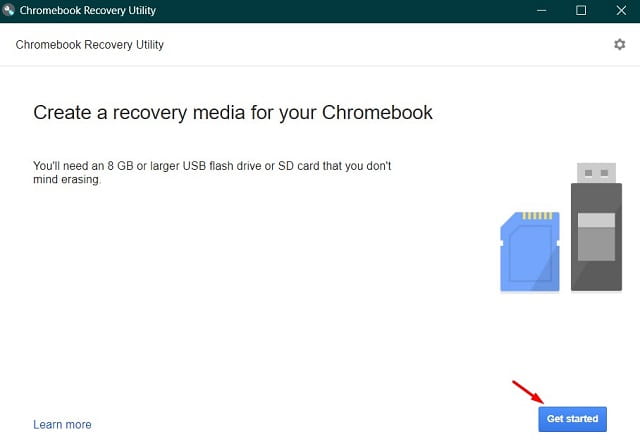
- On the subsequent screen, type the model number that you would like to install on your PC. In case you don’t know the model number, hit the link and select a model from a list.
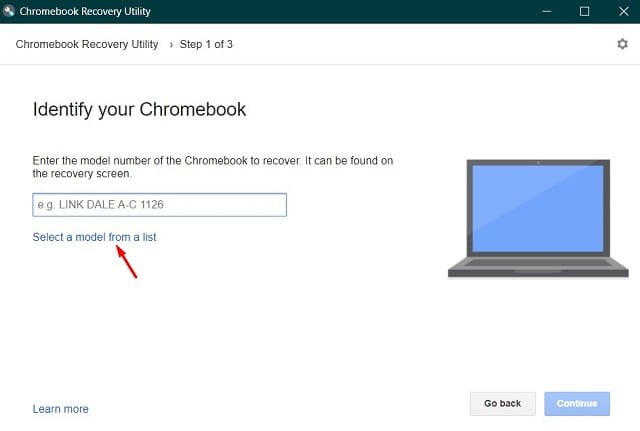
- Now, identify your Chromebook by choosing Google Chrome OS Flex as manufacturer, and Chrome OS Flex (developer-unstable) as the product name.

- The Continue button will appear greyed out if you haven’t yet inserted the USB flash drive. Insert the media drive, select it, and hit the Continue button.
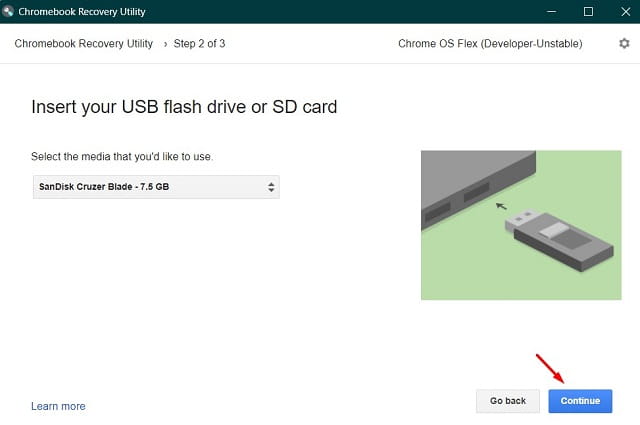
- Click Create now to begin creating a recovery image on the chosen USB drive.
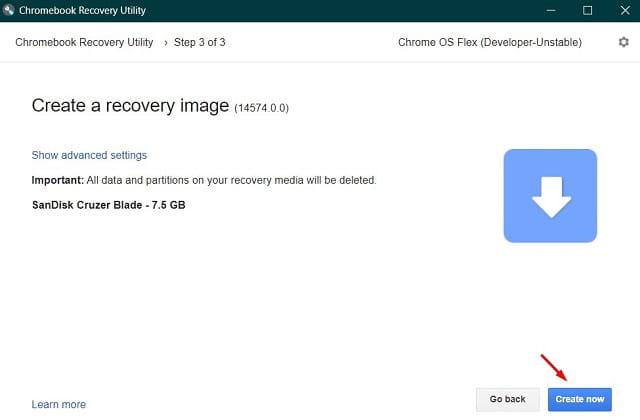
- The file download will soon begin.
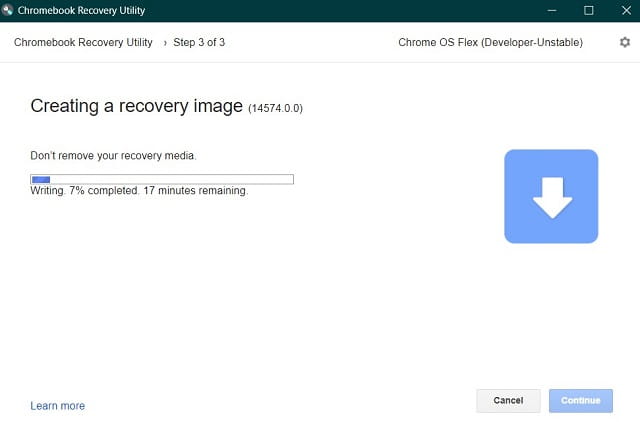
- When you get the message – “Success! Your recovery media is ready”, hit OK.
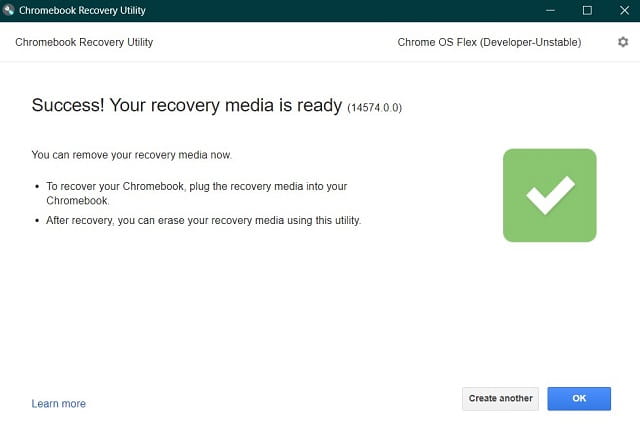
Now that you have created the bootable drive, restart your PC.
Installing Chrome OS Flex
Follow these instructions to install Chrome OS Flex on a Windows device –
- Plug the Chrome OS Flex bootable drive into one of your PC’s ports and restart it.
- While your computer is rebooting, press the F8 key to open the boot menu. Each PC’s manufacturer provides its boot key, so press that function key, Esc, or Del.
- Select the attached USB Flash drive using the arrow keys and press Enter.
- The new Chrome OS logo will now appear. Wait for the computer to boot again and when it does, the new OS installation begins.
- You will see two options to choose from. Go with the Cloud Ready 2.0 option as this way, you are going to fresh install Chrome OS on your computer.
- Accept all the terms that appear inside the upcoming window.
Now sit back and watch the process of installing Chrome OS on your Windows PC. Unplug the USB drive and restart your device once the installation is complete. To set up Chrome OS Flex, follow the on-screen instructions.
Can I use Chrome OS Flex without installing it?
Though clean installing an operating system is considered best, you may also use Chrome OS without even installing it. Indeed, this is a great option to start with, as this way you may try the features it offers. To complete this task, all you’ll need is a USB drive (minimum of 8 GB) for this. Let’s see how it actually works –
- Attach the Chrome OS Flex drive into one of the Windows ports and restart your PC.
- While it’s loading, press the function key (F8, Esc, Del).
- When the boot menu appears, select your external USB drive.
- Press Enter to see the “new Chrome OS logo”.
- Now follow the onscreen instructions to complete the remaining steps.
I hope you found this post helpful and informative.